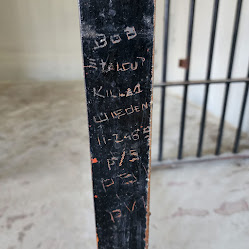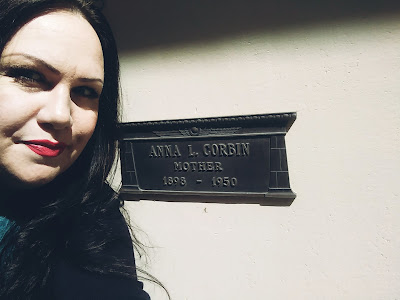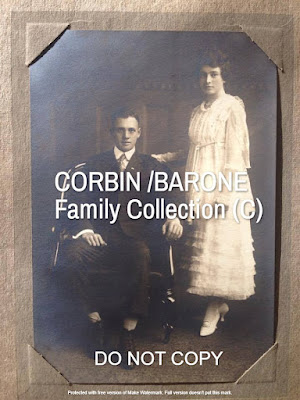I wanted to clarify a
few things that were stated recently in an article in the Ledger Dispatch that just didn't hold up when examined by the facts. The
interview that was published was with the curators of the most recent photograph and media exhibit
being held at Preston this summer. I am unsure where the ladies who were interviewed
got their research from, but I wanted to clarify a few things here so that the
public would know the actual facts in order to clear up any misinformation.
First and foremost, the majority of the boys that were sent to Preston over the years while the school was open, were there because of crimes they had committed, but yes, not all the boys were criminals, especially in its inception. Many of the boys in the early years were homeless, or their parents were unable to financially support them. Some were considered “incorrigible” but not necessarily worthy of going to jail.
Depending on the time period when the boys were sent to “the Castle,” that depended on the type of experiences one would have there. In the school’s infancy, there were a lot of hiccups you could say, and mistakes made by some of those who were in charge. The school had earned the reputation of the “Preston School of Scandal,” for a reason. There were accusations made that certain Superintendents had abused the boys. One of the more infamous stories was of Superintendent O’Brien who was accused of literally torturing some of the wards, which was published in the newspapers, and he did eventually step down from his position.
Still, there were plenty of Superintendents that were focused on truly wanting to help the boys learn to become upstanding members of society, so that upon their release they could go out and find work and make a better life for themselves. Please believe that not all the people running Preston were ruling with an iron fist.
In my books and here on my ongoing blog "Preston Castle
History," I like to refer to Preston as a mixed bag of sorts, because
along with the bad stories, there were also many good ones. There were a lot of
people who worked there, some of them their entire lives, intent on helping the
youth do better. There are a lot of stories of the boys who left the school to
become successful members of society, too.
To clarify a few things, the boys at Preston were not all treated as though they had committed crimes, as the staff knew very well which boys were sent there and for what reasons such as the child being an orphan, his parents couldn’t financially afford to support him, or even worse possibly vagrancy. Then there were other boys sent to Preston for continual truancy, incorrigibleness and yes, committing crimes, petty or even some serious ones. To adamantly state that the school operated under that opinion, that they believed they were all guilty, is a disservice and a disrespect to all who worked so tirelessly at that school hoping to help these boys make better lives for themselves.
Going back to the way the wards were treated. Yes, at times there were boys who were paddled or flogged for disobedience or getting out of line, but you must remember that during that time in history those forms of corporal punishment were considered the norm. I agree at times it got out of hand, especially with Superintendent O'Brien; However, even in some of the later Preston Biennial reports they stated that they only resorted to those methods if all other methods to get through to the wards were exhausted, not that I think that was okay. One of the Superintendents who wrote in one of the the Biennial reports mentioned that he felt corporal punishment was no good and did nothing positive for the wards. So as you can see, not everyone agreed with those methods. Again, it depended on the time period. Eventually corporal punishment* as a whole was stopped.
And yes, it was Corporal Punishment, not Capital Punishment as the article states. There is a HUGE DIFFERENCE! (*There were no executions at Preston!)
There were two choices at the time, send the boys to Preston or Whittier, another reformatory at the time, or be sent to the Penitentiary such as Folsom or San Quentin, where the hardened criminals were housed. The odds were they would have left institutionalized had they been sent to the latter. So, Preston was the lesser of two evils, no doubt.
One of the quotes in the article stated: "The injustice is, these boys were put in the middle of nowwhere, locked down in solitary confinement and unable to have freedom of movement, and they were children."
That statement couldn't be further from the truth. For one, there were no fences at Preston when they opened. It was an open campus. People from Ione wandered up there from time to time, and even later, Ione residents were able to come and take trades classes there alongside the wards. Anna Corbin's son, Harold was one of those residents who took classes there.
Second, they were not all put in solitary confinement. There were some events in the early years noted in record where the boys said to have been kept in the basement -- these were the written experiences of the wards themselves. But as a whole the boys were free to roam the property, work on the farm, in the blacksmith shop, in the print shop, in the bakery, and all the other departments where they were able to work and learn trades. They were able to go swimming on certain days of the week, and they were able to take care of the animals on the farm. They lived in honor cottages and buildings, not the solitary lock up buildings - those were for the boys who were being punished for bad behavior. Also, the fact the boys were doing work at Preston was not for the benefit of Preston itself, although everyone benefited, even the town, but it was to teach the boys life skills so that when they were released they would be able to support themselves out in the world.
In the article it mentioned “The general
population chose to harbor rampant discrimination and extreme exclusion via
racism, homophobia, classism and povertyism – operating under the opinion that
if these people were innocent, they would not have been arrested.”
I am going to have to disagree on that statement – which by the way is not supported by facts. For one, the Biennial Report for the Preston School of Industry published in 1918, showed that “the occurrence of serious crimes is most frequent among the white American boys and least frequent among the colored Americans.”
In my research for the many years that I have been doing so, I have found no records to imply that anyone was discriminated against by race at Preston-- at least not during the time periods in which I researched (during the Administration buildings years of being open). I saw white, black and Hispanic boys alike being treated the same in the stories and records I have recovered.
The school often based their opinions on the boys by using the Binet-Simon Intelligence Scale which measured mental abilities such as judgement, reasoning and comprehension. By 1916, that test was replaced by the Stanford-Binet Intelligence Scale, to determine their cognitive abilities based on fluid reasoning, quantitative reasoning, knowledge, visual-spatial processing and working memory. This was to determine their intellectual weaknesses and strengths. It was not about racism or homophobia, and it certainly wasn’t based on classism.
In fact, one of the wealthier of the wards, Herman Huber, was sent to Preston not having committed any crime at all, but more than likely because he was disobeying his grandfather or family members. The Preston admission ledger only had the word "Delinquent" next to Herman's name. His experience there was not a good one, and he never left Preston -- alive anyway. Herman was shot and killed by a guard during a botched escape attempt, and an eye-witness reported the incident to the Governor after his release from the school.
Yes, Preston had records where they kept track of demographics such as where the boys came from, their backgrounds, their crimes and yes, their race. However, the records show that the boys who were made to do the most “disagreeable work,” such as hard labor, were doing so for acting out and not going along with the program, not because of the color of their skin. Remember this was a reform school to teach discipline, education and a trade. The school had rules to abide by, similar to the military. From the moment you stepped foot on the grounds you were expected to follow the rules. The boys were assigned to a company, not unlike in the military. You were expected to respect and follow the rules – and if you fell short, the entire company would be punished (not physically – but privileges taken away), just like in the military.
During the time period where they had implemented a
form of self-government, the boys had a choice – act right, do what was
expected of you and you would move up, if you chose to disobey and cause
problems you would be demoted. Segregation, if any, wasn’t
classified by race or ethnicity, but based on their age groups and what they
were sent to Preston for, as the administration learned a hard lesson when
during the earlier years of the school’s operations the new boys
were “indiscriminately mixed with the older institution types,
feeble-minded with normal boys, moral degenerates with innocent first offenders
or dependents.” That was a recipe for disaster.
As the years went on the more problematic boys were often sent to solitary confinement for a period of time, until they were willing to cooperate. The wards who were attending classes and keeping up on the program at Preston found themselves earning more and more credits and being given more privileges.
“He has just as many opportunities for wrong decisions as for right ones, just as many chances to go wrong as to go right. If he goes wrong, he is not combating the social order of his mental and social superiors in civilization, which he cannot respect, but he is combating his social and mental peers whom he understands and must respect. His comfort, happiness and progress depend upon his social relations; his social relations upon his free choice of conduct in the field of self-government. This, then, is the starting point for the boy: to make him conscious that he is a free moral agent and that his every decision affects his own life and status, and at Preston he makes that start the first day he arrives.” – Preston 12th Biennial Report, page 6.
According to Bruce Warner, who worked at Preston for over 40 years, starting in the early 1950s, and was both a cook and later on security detail there, stated that at its highest population during his time at Preston in the 1950s, he was feeding 1,000 wards breakfast every morning. There were a lot of boys who came and left that school. Some had bad experiences, some had good. I have interviewed some who were there going back to the 50s, 60s and even 70s, and they all said that if you kept your head down and didn't cause problems you would be okay, but if you caused problems you would go to solitary and make things harder for yourself.
The article mentioned a visit to the cemetery, which is normally off limits because it is on CalFire property and is no longer part of the Preston property. So for the public, please do not attempt to visit the cemetery!
Regarding some of the deaths mentioned, 10 year old Grant Walker, was a young white American child, who came from a very large and very poor family. His father was a stagecoach driver and married someone who had many children from a previous marriage. It is my belief that the family fell on very hard times and that Grant ended up in the system because of their inability to care for him. This was not uncommon and I have found that to be the case many times. Sadly, Grant became ill with typhoid fever, a very common disease during that time period and sadly he passed away.
In my book, "If These Walls Could Talk: More Preston Castle History," I questioned the first two deaths reported in the Biennial Report for 1895. I have mentioned this on my blog as well. The first two deaths that I could find in records was Adolf Antron and Grant Walker. Adolf died from pulmonary adema and Grant was said to have died from typhoid fever as mentioned above.
The Biennial Report however mentioned the second death as "an accidental burn resulting in an intestinal ulceration." This is why I questioned Grant's death in my book, but let me be clear, the report never gave a name. This left a big question mark in my mind. Was that death by way of a chemical burn Grant, or another ward whose name was simply forgotten? One whose body had been removed by family and buried elsewhere? We will never know for certain. However, Grant's official cause of death was said to be typhoid fever, and without an autopsy report that states otherwise, we cannot say adamantly that it was anything other than that.
The newspaper article also adamantly stated that "13 year olds don’t die of a stroke."
To answer that, a “stroke of apoplexy,” which is what 17 year old Peter Miller died of, was something that did afflict people, young and old alike. It can be caused by a blood clot blocking the flow to the brain which is an ischemic stroke. You can also die from a stroke, caused from bleeding to the brain, types of blood clotting disorders, infections and even heart conditions. In teenagers, it can even be caused by a tumor in the pituitary gland.
Another death, Frank Ward, who died at age 17, from “Dementia” actually died from “Dementia Paralytica” which was primarily caused from a late-stage neurosyphilis, which the person could have contracted at birth from their mother who had the disease.
Yes, in my research I have found a few deaths that I found suspicious, not the ones mentioned in the article as those were natural causes; However, even with the research I have done, I cannot say 100% that the deaths I have suspected of possible foul play were actually homicides, nor can I make a statement that the deaths do not match the forensics. There was no forensics. The cause of death would have been determined by the coroner at the time, an upstanding man in the community whom I have researched and written about countless times. The ward's families were either unable to be located to notify them of the death, or the family was not financially in a position to retrieve the body to be buried elsewhere, and so the young deceased ward was buried on the property. There really is nothing suspicious about that.
Lastly, the article quoted one of the ladies stating “These
are ongoing themes, people living in poverty, immigrants who didn’t have access
to schooling or the ability to thrive.” -- If you were to look at the
records, at least for the first 75 years of Preston's history, the majority of
wards there were not all immigrants -- but primarily American Caucasian boys.
Yes, over time the population of Hispanic and African-American wards increased
tremendously, but to really put things in perspective, the boys and/or young men
who were sent to Preston over the majority of the time it was in operation,
those were boys of all races, all religions, all ethnic backgrounds and all
walks of life -- You could say that Preston was actually the great equalizer.
I hope that after reading this blog you will see a more level headed perspective of the school's history. Yes, there were stories of abuse and mistreatement at different times during the school's history - I am not denying that; However, we cannot deny that the school did do a lot of good for a lot of boys who would have never stood a chance in the world without their help. Some boys that went to Preston went on to lead successful lives, and yes, some remained forever in the system, institutionalized. In reality, every boy who stepped foot on that campus had a chance to do better while there at Preston, and in the end it was up to their state of mind, their choice whether or not they would learn from their experience and do better, or use these experiences as a crutch for the rest of their life that determined where their journey would lead them as adults.
(J'aime Rubio - Copyright 8/30/2025 - www.jaimerubiowriter.com)
























